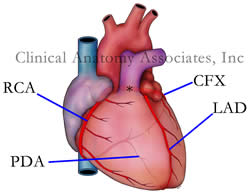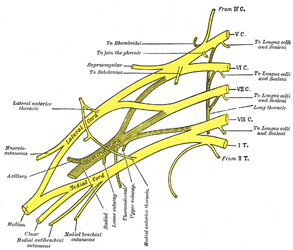
Medical Terminology Daily (MTD) is a blog sponsored by Clinical Anatomy Associates, Inc. as a service to the medical community. We post anatomical, medical or surgical terms, their meaning and usage, as well as biographical notes on anatomists, surgeons, and researchers through the ages. Be warned that some of the images used depict human anatomical specimens.
You are welcome to submit questions and suggestions using our "Contact Us" form. The information on this blog follows the terms on our "Privacy and Security Statement" and cannot be construed as medical guidance or instructions for treatment.
We have 230 guests online

Georg Eduard Von Rindfleisch
(1836 – 1908)
German pathologist and histologist of Bavarian nobility ancestry. Rindfleisch studied medicine in Würzburg, Berlin, and Heidelberg, earning his MD in 1859 with the thesis “De Vasorum Genesi” (on the generation of vessels) under the tutelage of Rudolf Virchow (1821 - 1902). He then continued as a assistant to Virchow in a newly founded institute in Berlin. He then moved to Breslau in 1861 as an assistant to Rudolf Heidenhain (1834–1897), becoming a professor of pathological anatomy. In 1865 he became full professor in Bonn and in 1874 in Würzburg, where a new pathological institute was built according to his design (completed in 1878), where he worked until his retirement in 1906.
He was the first to describe the inflammatory background of multiple sclerosis in 1863, when he noted that demyelinated lesions have in their center small vessels that are surrounded by a leukocyte inflammatory infiltrate.
After extensive investigations, he suspected an infectious origin of tuberculosis - even before Robert Koch's detection of the tuberculosis bacillus in 1892. Rindfleisch 's special achievement is the description of the morphologically conspicuous macrophages in typhoid inflammation. His distinction between myocardial infarction and myocarditis in 1890 is also of lasting importance.
Associated eponyms
"Rindfleisch's folds": Usually a single semilunar fold of the serous surface of the pericardium around the origin of the aorta. Also known as the plica semilunaris aortæ.
"Rindfleisch's cells": Historical (and obsolete) name for eosinophilic leukocytes.
Personal note: G. Rindfleisch’s book “Traité D' Histologie Pathologique” 2nd edition (1873) is now part of my library. This book was translated from German to French by Dr. Frédéric Gross (1844-1927) , Associate Professor of the Medicine Faculty in Nancy, France. The book is dedicated to Dr. Theodore Billroth (1829-1894), an important surgeon whose pioneering work on subtotal gastrectomies paved the way for today’s robotic bariatric surgery. Dr. Miranda.
Sources:
1. "Stedmans Medical Eponyms" Forbis, P.; Bartolucci, SL; 1998 Williams and Wilkins
2. "Rindfleisch, Georg Eduard von (bayerischer Adel?)" Deutsche Biographie
3. "The pathology of multiple sclerosis and its evolution" Lassmann H. (1999) Philos Trans R Soc Lond B Biol Sci. 354 (1390): 1635–40.
4. “Traité D' Histologie Pathologique” G.E.
Rindfleisch 2nd Ed (1873) Ballieres et Fils. Paris, Translated by F Gross
"Clinical Anatomy Associates, Inc., and the contributors of "Medical Terminology Daily" wish to thank all individuals who donate their bodies and tissues for the advancement of education and research”.
Click here for more information
- Details
- Written by: Efrain A. Miranda, Ph.D.
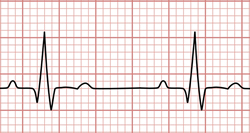
Sinus rhythm electrocardiogram
A contraction, from the Greek [συστολή] (systolí) meaning “contraction”, also [συστελλει] (systellei) meaning “to shrink, to shorten, or to draw together”.
It refers to the contraction of the heart. If you analyze a normal heartbeat (sinus rhythm), there are two systoles: an atrial systole, followed by a short interval, followed by the ventricular systole. The term systole is usually used in reference to the ventricular systole.
Systole was first recognized and named by Herophilus of Alexandria (325-255BC), most probably trough animal vivisection. Herophilus was accused of animal vivisection and the dissection of human cadavers. Because of this, some call Herophilus "The Father of Anatomy".
Galen of Pergamon (129AD - 200AD) used the term [συστελλεσθαι] meaning “contracted”.
The word in English was first used in the 16th century and was originally written as “sistole”, with an "i" instead of the accepted use today with a "y". The modern pronunciation in English follows the Greek pronunciation by ending the word in a long “e” as in “to be”.
Sources
1. "The Origin of Medical Terms" Skinner, HA 1970 Hafner Publishing Co.
2. "Medical Meanings - A Glossary of Word Origins" Haubrich, WD. ACP Philadelphia
3. "Dorlands's Illustrated Medical Dictionary" 26th Ed. W.B. Saunders 1994
4. "Greek anatomist Herophilus: the father of anatomy" Si-Yang, N. Anat Cell Biol. 2010; 43(4): 280–283
Note: Google Translate includes an icon that will allow you to hear the pronunciation of the word
- Details
- Written by: Efrain A. Miranda, Ph.D.

Sinus rhythm electrocardiogram
Sinus Rhythm (SR), also known as Normal Sinus Rhythm (NSR) is the term used to denote normal cardiac activity. A normal beating heart is in sinus rhythm.
In the normal beating of the heart the left and right atria contract followed by the contraction of the left and right ventricles. These atrial and ventricular contractions are separated by a lag time of 1/10th of a second which allows the atria to relax (atrial diastole) while the ventricles contract (ventricular systole). The addition of the normal action of the four heart valves (tricuspid, mitral, aortic, and pulmonary) allows the heart to work as a blood pump and circulate blood within the heart and through the body and lungs.
SR is coordinated by a complex binary conduction system. The first part of the conduction system is composed of heart muscle cells (cardiomyocytes) which are characterized by automaticity. It is important to state here something that is known, but many times ignored: This portion of the conduction system is not composed of nerves... it is formed by specialized cardiac muscle cells! The description of this cardiomyocyte-based system can be read in a separate article here.
The second component of the conduction system is the cardiac autonomic nervous system (CANS), which acts as a moderator (accelerating or slowing) the cardiomyocyte-based conduction system. A separate article will be written soon and linked here. Suffice it to say (for now) that the CANS has two components, an extrinsic component formed by nerves and ganglia outside the heart, and an intrinsic component of nerves and ganglia that forms a complex network within the superficial aspect of the heart muscle and fat surrounding the heart. These are the ganglionated plexuses, and their dysfunction can cause abnormal heart rhythm.
When these two components and their thousands of cardiac muscle cells, ganglia, and nerves are working property, the heart is in sinus rhythm, and beats between 60 to a 100 times per minute.
Personal note: The term Normal Sinus Rhythm (NSR) is redundant. By definition, if the heart is in SR, it is normal. On the other hand, the term Abnormal Sinus Rhythm is also not correct… if the heartbeat is abnormal, the heart is not in SR! (Dr. Miranda)
- Details

Histology image of cardiac muscle*
[UPDATED] Cardiac muscle is one of the three types of muscle found in the human body. It is found exclusively in the heart, where it forms the main component of its middle layer, the myocardium.
[Myo]=combining form for "muscle"; [-card-]=heart; and [-ium]=layer or membrane. The myocardium is the muscle layer of the heart.
Cardiac muscle has distinct striations and intercalated discs (see accompanying image). The cardiac muscle acts as a functional syncytium.
The key characteristic of cardiac muscle is automatism or automaticity, its capacity to contract rhythmically in the absence of an external electrical stimulus. The other two types of muscle (smooth and skeletal) lack this characteristic.
The term [cardiomyocyte] can be used to describe each of these cells as the word is composed of [Card(i)o=combining form for "heart"; [myo]=combining form for "muscle"; and the suffix [-cyte]= cell. A cardiomyocyte is a cardiac muscle cell.
One of the components of the conduction system of the heart is made exclusively of cardiomyocytes.
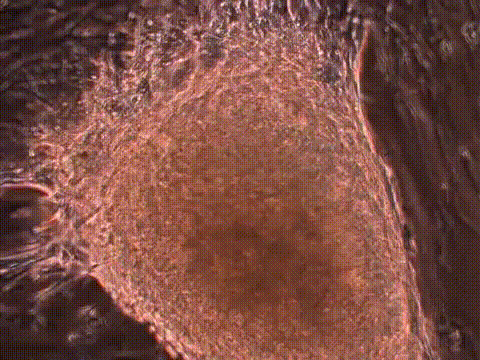
Image modified from the original on YouTube from the British Heart Foundation.
* Original histology image by S, Girod and A. Becker, courtesy of Wikipedia.
- Details
- Written by: Efrain A. Miranda, Ph.D.
[UPDATED] These two root terms mean "heart".
The first one, [-card(i)-] arises from the Greek [καρδιά] pronounced kardiá, and can be seen in medical words such as: cardiac, echocardiogram, cineangiocardiogram, cardioplegia, myocardial infarction, etc.
The second one [-cord(i)-] arises from the Latin [cor] or [cordis] and can be seen in words such as: precordial pain, cordial, commotio cordis, etc.
As a point of interest, the original Greek spelling of [kardium] was used by Nobel prize winner Dr. Willem Einthoven (1860 - 1927) when he invented the electrocardiograph and the electrocardiogram. The German term is [elektrokardiogramm] and the German abbreviation for the procedure is EKG. Since we use the term in English, [electrocardiogram] we use the abbreviation ECG. Both are correct, although if you are speaking English, ECG should be used.
* Image property of:CAA.Inc.. Artist:Victoria G. Ratcliffe
- Details
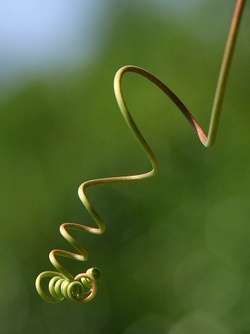
Vine tendril. Image courtesy of Jon Sullivan
The term [pampiniform] comes from the Latin term [pampinus] meaning "a vine tendril". It refers to a twisted, curved structure as seen in the accompanying image. The second portion of the word also comes from Latin, [forma] means "shape" or "in the shape of".
Pampiniform then means "in or with the shape of a vine tendril"
Although mostly associated with the pampiniform plexuses found in both the testicular veins in the spermatic cord and the ovarian veins found within the infundibulopelvic ligament, the term is also used to denote the coiled aspect of the organ of Rosenmuller, also known as the pampiniform body or paraovarium.
The pampiniform body is a non-functional embryological remnant of the development of the female reproductive system. It is composed of a blind longitudinal duct and 10-15 transverse smaller ducts. It is located in the mesosalpinx, an extension of the broad ligament related to the uterine tube (Fallopian tube).
Thanks to David Van Tol for suggesting this article!
Image courtesy of Jon Sullivan, Public domain, via Wikimedia Commons https://jonsullivan.com/
- Details
UPDATED: The term [plexus] comes from the Latin term [plectere] meaning " to twine, or to braid". In anatomy, the term [plexus] refers to a group of structures that are intertwined or form a meshwork. The plural form is [plexuses], although the Latin plural form [plexi] is also correct. Gabrielle Fallopius used the term to denote "a tangle of nerves"
There are many plexuses described in the human body. Most are formed by nerves, but there are many that are lymphatic or vascular. The best known are the plexuses of nerves formed by the ventral rami of the spinal nerves. These are the cervical plexus, the brachial plexus, the lumbar plexus, and the sacral plexus. The image depicts the brachial plexus. For a larger version, click on the image, and for further information on the cervical and brachial plexuses, click here.
Images and links courtesy of:www.bartleby.com


